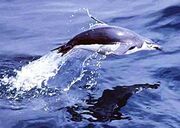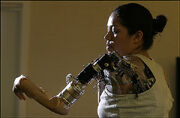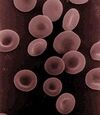Assessment |
Biopsychology |
Comparative |
Cognitive |
Developmental |
Language |
Individual differences |
Personality |
Philosophy |
Social |
Methods |
Statistics |
Clinical |
Educational |
Industrial |
Professional items |
World psychology |
Biological: Behavioural genetics · Evolutionary psychology · Neuroanatomy · Neurochemistry · Neuroendocrinology · Neuroscience · Psychoneuroimmunology · Physiological Psychology · Psychopharmacology (Index, Outline)
Biomechanics is the research and analysis of the mechanics of living organisms or the application and derivation of engineering principals to and from biological systems. The research and analysis can be carried forth on multiple levels, from the molecular, wherein biomaterials such as collagen and elastin are considered, all the way up to the tissue and organ level. Some simple applications of Newtonian mechanics can supply correct approximations on each level, but precise details demand the use of continuum mechanics.

Chinstrap Penguin
Aristotle wrote the first book on biomechanics, De Motu Animalium, or On the Movement of Animals. He not only saw animals' bodies as mechanical systems, but pursued questions such as the physiological difference between imagining performing an action and actually doing it. Some simple examples of biomechanics research include the investigation of the forces that act on limbs, the aerodynamics of bird and insect flight, the hydrodynamics of swimming in fish, and locomotion in general across all forms of life, from individual cells to whole organisms. The biomechanics of human beings is a core part of kinesiology.
Applied mechanics, most notably thermodynamics and continuum mechanics, and mechanical engineering disciplines such as fluid mechanics and solid mechanics, play prominent roles in the study of biomechanics. By applying the laws and concepts of physics, biomechanical mechanisms and structures can be simulated and studied.
It has been shown that applied loads and deformations can affect the properties of living tissue. There is much research in the field of growth and remodeling as a response to applied loads. For example, the effects of elevated blood pressure on the mechanics of the arterial wall, the behavior of cardiomyocytes within a heart with a cardiac infarct, and bone growth in response to exercise have been widely regarded as instances in which living tissue is remodeling as a direct consequence of applied loads.
Relevant mathematical tools include linear algebra, differential equations, vector and tensor calculus, numerics and computational techniques such as the finite element method.
The study of biomaterials is of crucial importance to biomechanics. For example, the various tissues within the body, such as skin, bone, and arteries each possess unique material properties. The passive mechanical response of a particular tissue can be attributed to characteristics of the various proteins, such as elastin and collagen, living cells, ground substances such as proteoglycans, and the orientations of fibers within the tissue. For example, if human skin were largely composed of a protein other than collagen, many of its mechanical properties, such as its elastic modulus, would be different.
Chemistry, molecular biology, and cell biology have much to offer in the way of explaining the active and passive properties of living tissues. For example, in muscle contractions, the binding of myosin to actin is based on a biochemical reaction involving calcium ions and ATP.
Applications[]

prosthetic articulating limb
The study of biomechanics ranges from the inner workings of a cell to the movement and development of limbs, the vasculature, and bones. As we develop a greater understanding of the physiological behavior of living tissues, researchers are able to advance the field of tissue engineering, as well as develop improved treatments for a wide array of pathologies.
Biomechanics as a sports science, kinesiology, applies the laws of mechanics and physics to human performance in order to gain a greater understanding of performance in athletic events through modeling, simulation, and measurement.
Continuum Mechanics[]
It is often appropriate to model living tissues as continuous media. For example, at the tissue level, the arterial wall can be modeled as a continuum. This assumption breaks down when the length scales of interest approach the order of the microstructural details of the material. The basic postulates of continuum mechanics are conservation of linear and angular momentum, conservation of mass, conservation of energy, and the entropy inequality. Solids are usually modeled using "reference" or "Lagrangian" coordinates, whereas fluids are often modeled using "spatial" or "Eulerian" coordinates. Using these postulates and some assumptions regarding the particular problem at hand, a set of equilibrium equations can be established. The kinematics and constitutive relations are also needed to model a continuum.
Second and fourth order tensors are crucial in representing many quantities in biomechanics. In practice, however, the full tensor form of a fourth-order constitutive matrix is rarely used. Instead, simplifications such as isotropy, transverse isotropy, and incompressibility reduce the number of independent components. Commonly-used second-order tensors include the Cauchy stress tensor, the second Piola-Kirchhoff stress tensor, the deformation gradient tensor, and the Green strain tensor. A reader of the biomechanics literature would be well-advised to note precisely the definitions of the various tensors which are being used in a particular work.
Biomechanics of Circulation[]

Under most circumstances, blood flow can be modeled by the Navier-Stokes equations. Whole blood can often be assumed to be an incompressible Newtonian fluid. However, this assumption fails when considering flows within arterioles. At this scale, the effects of individual red blood cells becomes significant, and whole blood can no longer be modeled as a continuum.
Biomechanics of the bones[]
Bones are anisotropic but are approximately transversely isotropic. In other words, bones are stronger along one axis than across that axis, and are approximately the same strength no matter how they are rotated around that axis.
The stress-strain relations of bones can be modeled using Hooke's Law, in which they are related by linear constants known as the Young's modulus or the elastic modulus, and the shear modulus and Poisson's ratio, collectively known as the Lamé constants. The constitutive matrix, a fourth order tensor, depends on the isotropy of the bone.
Biomechanics of the Muscle[]
There are three main types of muscles:
- Skeletal muscle (striated): Unlike cardiac muscle, skeletal muscle can develop a sustained condition known as tetany through high frequency stimulation, resulting in overlapping twitches and a phenomenon known as wave summation. At a sufficiently high frequency, tetany occurs, and the contracticle force appears constant through time. This allows skeletal muscle to develop a wide variety of forces. This muscle type can be voluntary controlled. Hill's Model is the most popular model used to study muscle.
- Cardiac muscle (striated): Cardiomyocytes are a highly specialized cell type. These involuntarily contracted cells are located in the heart wall and operate in concert to develop synchronized beats. This is attributable to a refractory period between twitches.
- Smooth muscle (smooth - lacking striations): The stomach, vasculature, and most of the digestive tract are largely composed of smooth muscle. This muscle type is involuntary and is controlled by the enteric nervous system.
Biomechanics of Soft Tissues[]
Soft tissues such as tendon, ligament and cartilage are combinations of matrix proteins and fluid. In each of these tissues the main strength bearing element is collagen, although the amount and type of collagen varies according to the function each tissue must perform. Elastin is also a major load-bearing constituent within skin, the vasculature, and connective tissues. The function of tendons is to connect muscle with bone and is subjected to tensile loads. Tendons must be strong to facilitate movement of the body while at the same time remaining compliant to prevent damage to the muscle tissues. Ligaments connect bone to bone and therefore are stiffer than tendons but are relatively close in their tensile strength. Cartilage, on the other hand, is primarily loaded in compression and acts as a cushion in the joints to distribute loads between bones. The compressive strength of collagen is derived mainly from collagen as in tendons and ligaments, however because collagen is comparable to a "wet noodle" it must be supported by cross-links of glycosaminoglycans that also attract water and create a nearly incompressible tissue capable of supporting compressive loads.
Recently, research is growing on the biomechanics of other types of soft tissues such as skin and internal organs. This interest is spurred by the need for realism in the development of medical simulation.
Viscoelasticity[]
Viscoelasticity is readily evident in many soft tissues, where there is energy dissipation, or hysteresis, between the loading and unloading of the tissue during mechanical tests. Some soft tissues can be preconditioned by repetitive cyclic loading to the extent where the stress-strain curves for the loading and unloading portions of the tests nearly overlap.
Nonlinear Theories[]
Hooke's law is linear, but many, if not most problems in biomechanics, involve highly nonlinear behavior. Proteins such as collagen and elastin, for example, exhibit such a behavior. Some common material models include the Neo-Hookean behavior, often used for modeling elastin, and the famous Fung-elastic exponential model. Non linear phenomena in the biomechanics of soft tissue arise not only from the material properties but also from the very large strains (100% and more) that are characteristic of many problems in soft tissues.
See also[]
- Anatomy
- Biomineralization
- E. Lloyd Du Brul
- Important publications in biomechanics
- Mechanics
- Orthosis
- Physiology
References[]
- Fung, Y.C. "Biomechanics: Mechanical Properties of Living Tissue" (2nd ed.). New York: Springer. ISBN 0-387-97947-6.
- Humphrey, Jay D. "Cardiovascular Solid Mechanics: Cells, Tissues, and Organs." New York: Springer. ISBN 0-387-95168-7.
- Vogel, Steven. (2003). Comparative Biomechanics: Life's Physical World. Princeton: Princeton University Press. ISBN 0-691-11297-5
- Ikada, Yoshito. Bio Materials: an approach to Artificial Organs (バイオマテリアル: 人工臓器へのアプローチ)
External links[]
- Center for Musculoskeletal Research at the University of Tennessee
- The Engineering Science and Mechanics (Biomechanics) program at Virginia Tech
- San Diego Orthopedic Biomechanics Research Center at Rady Children's Hospital and Health Center
- Biomechanics Laboratory - ENSAM Paris - CNRS UMR 8005 in French
- A Genealogy of Biomechanics
- The Biomechanics Lab - a medium for connection between individuals in the biomechanics field.
- Biomechanics Laboratory - Charité Berlin, Germany: Basic research with instrumented orthopaedic implants
- Biomechanics Laboratory FH-Aachen in German
| This page uses Creative Commons Licensed content from Wikipedia (view authors). |

